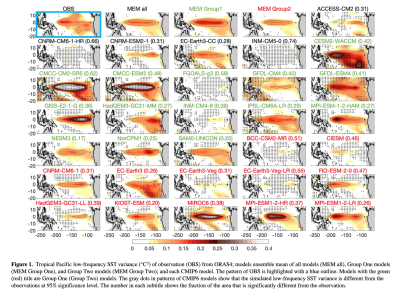A Pacific Tropical Decadal Variability Challenge for Climate Models
Tropical Pacific Decadal-scale Variability (TPDV) has been shown to impact global-scale climate fluctuations, weather regimes, and temperature trends such as the 1998–2012 global warming hiatus. Understanding and predicting TPDV's impacts strongly rely on climate model simulations and projections. However, the models show key deficiencies in reproducing the observed structure of TPDV. Although the arithmetic mean of TPDV's spatial pattern in each individual model is similar to observations, there is a large spread among models, and most models show significant differences from observations. Using an empirical dynamical model to decompose the mechanisms of the climate models reveals that more than 50% of the models fail to reproduce the roles of extratropics-tropics coupling and the tropical thermocline variability play in TPDV. These differences show significant challenges exist across the models for modeling the decadal-scale climate variability in the tropical Pacific. Improving the simulation of TPDV in climate models is vital for understanding the impacts of natural internal low-frequency variability alongside long-term climate change.
This research on Tropical Pacific Decadal-scale Variability (TPDV) underscores the critical importance of climate models in assessing future climate changes. Climate models are indispensable tools for predicting and understanding the implications of TPDV on global weather patterns, temperature trends, and overall climate fluctuations. This study highlights the substantial gaps and challenges in current models, particularly in accurately replicating the observed structure and mechanisms of TPDV, such as extratropics-tropics coupling and tropical thermocline variability. These discrepancies in modeling TPDV not only reveal the limitations of existing climate simulations but also emphasize the urgent need to enhance these models. Improved simulation of TPDV is essential for a more accurate representation of natural internal low-frequency variability, which is crucial alongside long-term climate change projections.
Understanding and forecasting Tropical Pacific Decadal-scale Variability (TPDV) strongly relies on climate model simulations. Using a Linear Inverse Modeling (LIM) diagnostic approach, we reveal Coupled Model Intercomparison Project Phase 6 models have significant challenges in reproducing the spatial structure and dominant mechanisms of TPDV. Specifically, while the models' ensemble mean pattern of TPDV resembles that of observations, the spread across models is very large and most models show significant differences from observations. In observations, removing the coupling between extratropics and tropics reduces TPDV by ∼60%–70%, and removing the tropical thermocline variability makes the central tropical Pacific a key center of action for TPDV and El Niño Southern Oscillation variability. These characteristics are only confirmed in a subset of models. Differences between observations and simulations are outside the range of natural internal TPDV noise and pose important questions regarding our ability to model the impacts of natural internal low-frequency variability superimposed on long-term climate change.

